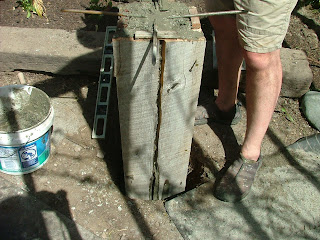The finished product.
We also needed some shade from the relentless Sun Valley sun and a structure for the grape vine to crawl over. The patio stone is 2000 pounds of 3-Rivers rock purchased from a local mason and the river rock was found by my children and me. They charge by the pound.
Pansy.
I transplanted a number of irises and bought some good-looking and cheerful pansies to satisfy my sense of a garden. Two small white Spirea bushes garnish the sides. I also planted some beans, radishes, and lettuce as this used to be our food garden. I planted three tomato plants and they froze the night I planted them! Strawberry plants line the back of the gazebo. In the above photo, you can see the garden swing and the chess table which account for the furnishings. I tiered the backside with rail-road ties that were laying in the back alley. I know strawberries like a raised garden.
Tamp the heck out of the cement to get rid of air pockets.
The Opening.
First up was creating a solid post. I was going to use a sonna-tube, but they cost $30+ and I settled for making a square post. Level the sides before pouring. Masonry rule #1: don't use old or recycled wood to build your form. After pouring nearly 200 lbs. of ready-mix post concrete into the form, the wood gave way and split allowing the concrete to spill out. Masonry rule #2: tamp the crape out of the wet concrete to dispell the air pockets. In the end the split formed a seam in the post length. The post required 2 1/2 bags of ready-mix concrete which I mixed in a bucket and successively poured into the form. The form is about 8 inches below the surface of the ground and I pounded a piece of t-post (large metal rod for fencing), down through the center of the form before I began dumping the concrete in. I went to a local metal-works shop and had them bend 3/8" steel rods in an L to add to the table support (cost $8). Ree-bar bends and supports but it gets brittle at the L and might snap during bending so I used a solid metal dowel. Pour some cement in the hole after the post is dry to add support. It took a couple of days to dry before I removed the form.
The post.
The middlegame.
I had to make the table base out of two pieces of plywood and fit them around the post about an inch down. The top was 24x24 inches. The sides of the form were made of 2x4. I also wired a section of old fencing to further support the table-top. Don't forget to make sure the table top is level! The concrete was a ready-mix, however, it was not your plane post-mix. I ordered Super 5000 concrete mix. The top took one 80 pound bag and poured 3 inches deep. While it was wet, I pushed 1 7/8-inch tiles into the cement for the black squares. Masonry rule #3: pre-measure the tiles!! Masonry rule #4: pre-layout the board and make it centered. Because I assumed they were 2 inch tiles as advertised the "7/8" amounted to the board being a whole inch off-center. Oh well, there is extra room on one side for a clock and a cocktail, now.
Support the base before you pour!
More supports.
To prevent the two pieces of plywood base from buckling under the weight of the concrete, I added some cross-beams to support the bottom of the table before pouring the cement. The table is 27 inches above the ground and the concrete chairs are 18 inches high. A great butt size is 11x8 inches. On retrospect, I would have made the stools about 20 inches. That way you would look more down at the table, rather than at my opponent. The garden chess table is more for social play, however, so it turned out fine and I love looking at my wife across from me. Soon I will have alternate opponents. The chairs were made from a rectangular form. The forms were set up so that 4 inches are underground. I used some ree-bar in the center of the form to add some more stability to the seat. Additional cement was poured into the outside portion of the hole as I did with the post. I pressed some extra tiles into the top of the seat, where your ischiums would be. Pea gravel from the alley feels good on your toes because playing chess in bare feet is nice in the summer. It also goes nice in between the patio rock.
End game.
I used green concrete stain to unify the whole structure and to highlight the board. On the gazebo is a solar night light that shines directly down on the board after sunset. This way, Lynnet and I can play while watching the stars.
Checkmate.
I have played 12 games on my new board and have won every one! Now I will spend my time on e-bay looking for a nice marble set that I can leave on the board to endure any weather. I hope this helps or inspires someone to build their own backyard chess table.
My chesssst.












